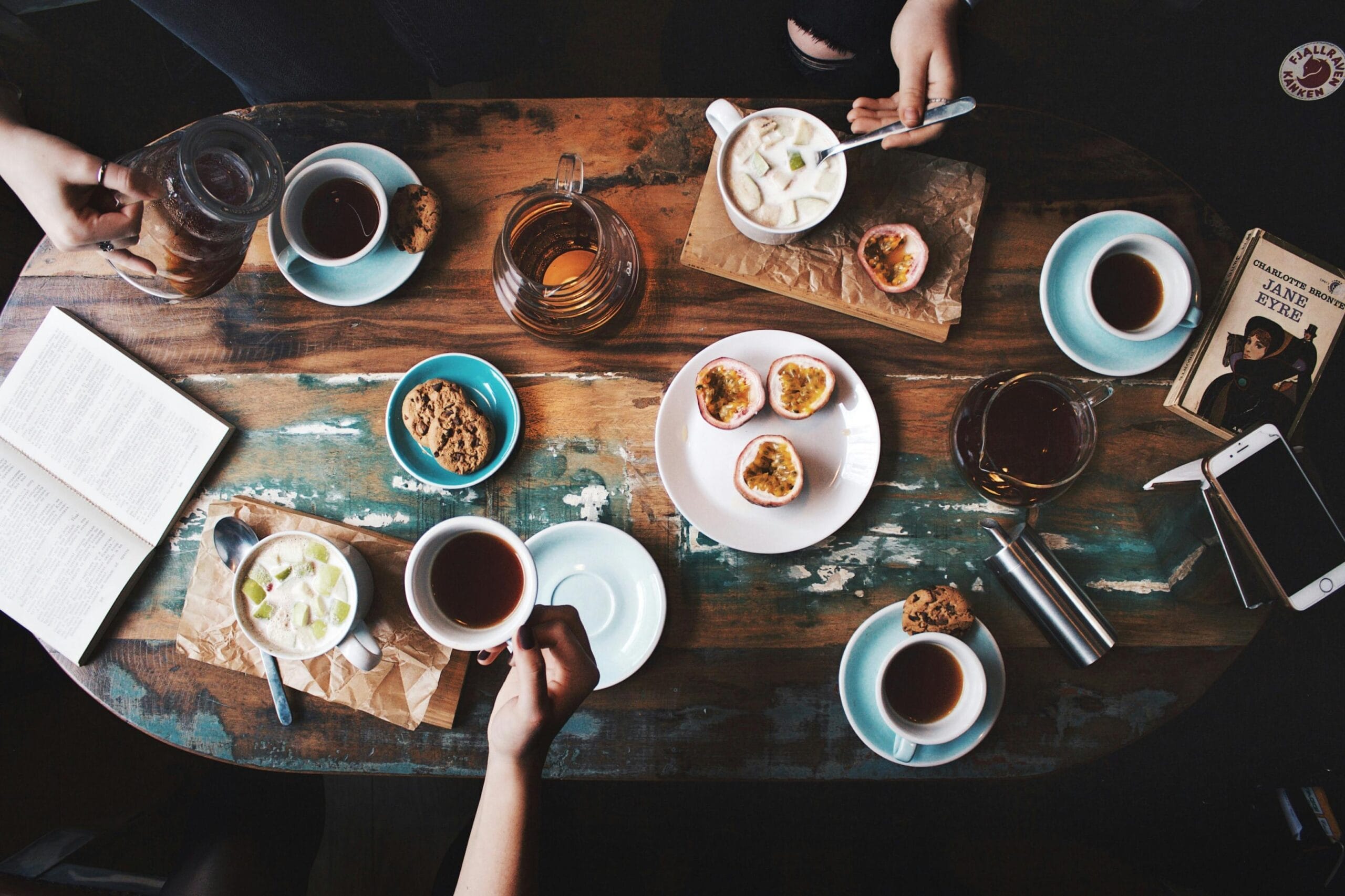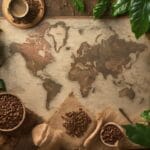Ready to crack the code of coffee connoisseurs? Think of this glossary as your secret decoder ring for navigating the exciting world of specialty coffee. With this guide to common terminology, you’ll be able to decipher those mysterious coffee menus, impress your barista with your newfound knowledge, and discuss your favorite brews like a seasoned adventurer.
Let’s embark on a journey to unlock those fascinating coffee terms and empower you to explore the nuances of your daily cup. Get ready to discover a whole new dimension of coffee!
A Sensory Symphony: Exploring Coffee’s Taste and Aroma
- Acidity: Don’t let the word scare you! In coffee, acidity refers to the bright, lively sensation that adds complexity and vibrancy to the flavor. Think of the tangy brightness of a citrus fruit or the crispness of a green apple. Acidity is often described using terms like “bright,” “tart,” “citrusy,” or “winey.”
- Example: A Kenyan coffee might be described as having “black currant acidity.”
- Aftertaste: The lingering flavor that remains in your mouth after swallowing coffee. A pleasant aftertaste can enhance the overall coffee experience. Aftertaste can be sweet, lingering, or even unpleasant, depending on the coffee and brewing method.
- Example: A Sumatran coffee might have an earthy, lingering aftertaste.
- Aroma: The smell of coffee, both in its whole bean and brewed form. The aroma can be incredibly diverse, with notes ranging from floral and fruity to chocolatey and spicy. Aroma is a key component of the coffee experience, influencing our perception of flavor.
- Example: An Ethiopian Yirgacheffe might have a floral aroma with hints of jasmine and bergamot.
- Balance: A harmonious combination of flavors in a cup of coffee, where no single element overpowers the others. A well-balanced coffee has a pleasing interplay of sweetness, acidity, and body.
- Example: A Colombian coffee might be described as having a “balanced flavor profile” with notes of chocolate, caramel, and a hint of citrus.
- Body: The feeling of the coffee in your mouth, ranging from light and delicate (like tea) to heavy and full (like cream). Body is influenced by the coffee bean variety, roast level, and brewing method.
- Example: A French press coffee might have a full body, while a pour-over coffee might have a lighter body.
- Flavor: The overall taste experience of coffee, combining taste (sweet, sour, bitter, salty) and aroma. Flavor is a complex sensory experience that is influenced by numerous factors, including the coffee’s origin, variety, processing method, roast level, and brewing method.
- Example: A Guatemalan coffee might have a flavor profile described as “chocolatey with notes of spice and a hint of citrus acidity.”
- Sweetness: One of the basic tastes, often associated with sugars and fruit flavors in coffee. Sweetness can range from subtle to pronounced and is influenced by factors such as the coffee variety, processing method, and roast level.
- Example: A naturally processed Ethiopian coffee might have a pronounced sweetness with notes of berries and stone fruit.
Behind the Scenes: Unveiling the Magic of Coffee Processing
- Bloom: The initial expansion of coffee grounds when hot water is poured over them, releasing trapped gases and enhancing the extraction process. The bloom is an important step in many brewing methods, allowing the coffee grounds to fully saturate and release their flavors.
- Example: When brewing pour-over coffee, you typically pour a small amount of water over the grounds and wait 30 seconds for the coffee to “bloom” before continuing the brewing process.
- Cupping: A professional coffee tasting method used to evaluate the aroma, flavor, and quality of coffee beans. Cupping involves grinding coffee beans, steeping them in hot water, and then carefully evaluating the aroma, flavor, and mouthfeel of the resulting brew.
- Example: Coffee professionals use cupping to assess the quality of green coffee beans before purchasing them, and roasters use cupping to evaluate the flavor profiles of their roasted coffees.
- Extraction: The process of dissolving soluble compounds from coffee grounds into water, creating the coffee brew. Extraction is influenced by factors such as grind size, water temperature, brewing time, and coffee-to-water ratio.
- Example: Over-extraction can result in a bitter and astringent coffee, while under-extraction can result in a weak and sour coffee.
- Roast Level: The degree to which coffee beans are roasted, ranging from light to dark. Roast level impacts the flavor, aroma, and body of the coffee.
- Example: Light roasts tend to have a higher acidity and more delicate flavors, while dark roasts have a fuller body and bolder, more roasted flavors.
The Brewer’s Arsenal: Essential Tools for Coffee Mastery
- Brewing Ratio: The ratio of coffee grounds to water used in brewing. This ratio significantly impacts the strength and flavor of the coffee. Brewing ratios are often expressed as a ratio (e.g., 1:16) or a percentage (e.g., 6.25%).
- Example: A common brewing ratio for pour-over coffee is 1:16, meaning 1 gram of coffee for every 16 grams of water.
- Filter Coffee: Any brewing method that uses a filter to separate the coffee grounds from the brewed coffee, such as pour-over, drip, or Chemex. Filter coffee methods generally produce a cleaner cup with less sediment.
- Example: The Hario V60, Chemex, and Kalita Wave are popular pour-over devices used to brew filter coffee.
- Grind Size: The size of the coffee particles after grinding, ranging from coarse (for French press) to fine (for espresso). Grind size is crucial for proper extraction and achieving the desired flavor profile.
- Example: Espresso requires a fine grind to ensure proper extraction under pressure, while French press coffee requires a coarse grind to prevent over-extraction.
From Crop to Cup: Understanding Coffee Beans
- Blend: A combination of coffee beans from different origins or varieties, creating a unique flavor profile. Blends are often created to achieve a specific flavor goal or to combine the best characteristics of different coffees.
- Example: A breakfast blend might combine beans from Brazil and Colombia for a balanced and approachable flavor profile.
- Origin: The country or region where the coffee beans were grown. The origin significantly influences the coffee’s flavor profile due to factors such as terroir and processing methods.
- Example: Ethiopian coffees are known for their floral and fruity flavors, while Sumatran coffees are known for their earthy and spicy notes.
- Single Origin: Coffee beans that come from a single farm, region, or country, showcasing the unique terroir of that specific origin. Single origin coffees allow you to experience the distinct flavors of a particular place.
- Example: A single origin coffee might be labeled as “Kenya AA,” indicating that the beans are from Kenya and meet the highest quality standards.
- Specialty Coffee: High-quality coffee beans that meet specific standards for flavor, aroma, and defect-free green beans, typically scoring 80 points or above on a 100-point scale. Specialty coffee is characterized by its exceptional quality, traceability, and unique flavor profiles.
- Example: Specialty coffee roasters often showcase unique and rare coffee varieties, such as Geisha or Pacamara, known for their exceptional cup quality.
- Variety: A specific type of coffee plant within a species, such as Bourbon, Typica, or Geisha, each with its own distinct flavor characteristics. Coffee varieties are developed through natural mutations or selective breeding, resulting in a wide range of flavor possibilities.
- Example: The Geisha variety, originally from Ethiopia, is known for its delicate floral aromas and complex cup profile.
Beyond the Bean: Other Essential Terms
- Brightness: A quality of coffee that describes its lively acidity and vibrancy. Brightness is often associated with high-grown coffees and specific processing methods.
- Example: A washed Ethiopian Yirgacheffe might be described as having a “bright and sparkling acidity.”
- Crema: The creamy, reddish-brown layer on top of espresso, indicating a well-extracted shot. Crema is formed by the emulsification of coffee oils and is a sign of a quality espresso.
- Example: A well-pulled espresso shot should have a thick, golden-brown crema that persists for several minutes.
- Terroir: The unique combination of environmental factors, including soil, climate, and altitude, that contribute to the distinctive flavor of coffee from a specific origin. Terroir plays a crucial role in shaping the flavor profile of coffee, just as it does with wine.
- Example: The volcanic soil and high altitude of the Antigua region in Guatemala contribute to the unique flavor characteristics of Antigua coffee.
Mastering the Lingo: Your Coffee Journey Continues
By familiarizing yourself with these essential coffee terms, you’ll be well-equipped to navigate the exciting world of specialty coffee. You’ll be able to confidently discuss your preferences with baristas, explore new coffee varieties, and deepen your appreciation for the nuances of this beloved beverage.
But this is just the beginning! The world of coffee is vast and ever-evolving, with new terms and concepts constantly emerging. As you continue your coffee journey, keep your senses sharp and your curiosity piqued. Embrace the challenge of learning and exploring, and let each cup of coffee be a gateway to new discoveries and deeper appreciation.
Up Next: Seed 103: Brewing Fundamentals
Now that you’ve mastered the language of coffee, it’s time to put your knowledge into practice! In the next chapter, we’ll delve into the essential techniques and tools for brewing delicious coffee at home. Get ready to unlock the secrets of brewing mastery!





No Comment! Be the first one.